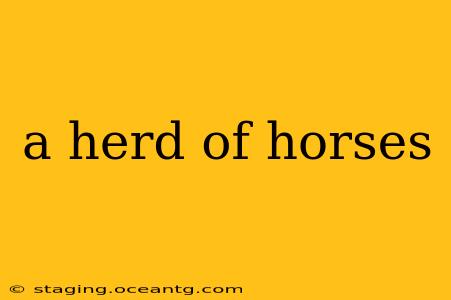A Herd of Horses: Exploring the Social Dynamics and Ecology of Equine Groups
A herd of horses is more than just a collection of individual animals; it's a complex social unit with intricate dynamics and a fascinating interplay of behavior, ecology, and survival. Understanding the intricacies of a horse herd offers a glimpse into the captivating world of these magnificent creatures. This exploration delves into the social structures, communication methods, and ecological roles of equine groups, answering common questions and providing a deeper understanding of these magnificent animals.
What is a group of horses called?
A group of horses is generally referred to as a herd. While the term "herd" can be applied to various groups of animals, in the context of horses, it specifically denotes a social unit typically consisting of related mares (female horses), their offspring, and often a dominant stallion (male horse). However, it's important to note that horse herd structures can vary depending on factors like species (e.g., Przewalski's horses have different social structures than domestic horses), geographic location, and available resources. Sometimes, all-male bachelor groups may exist separately from the main herd.
What are the social structures within a horse herd?
The social structure within a horse herd is largely matriarchal, meaning the mares, typically related, hold the central positions of power and influence. A dominant mare often leads the herd, determining grazing areas, movement patterns, and overall herd safety. The hierarchy among mares is often established through subtle displays of dominance, such as body posture, ear position, and subtle aggressive interactions. A stallion's role primarily revolves around protecting the herd and ensuring the survival of his offspring. However, his authority is often subordinate to the overall social order of the mares. Young horses learn social cues and behaviors by observing and interacting with older members of the herd, fostering a strong sense of community and cooperation.
How do horses in a herd communicate?
Horses utilize a complex communication system encompassing various methods. Visual communication plays a vital role; subtle shifts in body posture, ear position, tail movements, and facial expressions convey important information about the horse's emotional state and intent. Auditory communication involves a range of vocalizations, including whinnies, snorts, and nickers, used for contact calls, alarm signals, and social interactions. Olfactory communication (scent) is also crucial, with horses utilizing pheromones to identify individuals and assess reproductive status. The intricate interplay of these communication methods ensures efficient coordination and cooperation within the herd.
How large is a typical horse herd?
The size of a horse herd varies considerably depending on factors like environmental resources and the availability of food and water. In wild populations, herd sizes can range from a small family group of a few individuals to larger aggregations of dozens of horses. Domestic horse herds, depending on management practices, can also vary significantly in size. Larger herds provide increased protection from predators but also increase competition for resources. Smaller herds offer greater individual access to resources but may be more vulnerable to predation.
What are the ecological roles of horses in their herds?
Horses, as herbivores, play a crucial role in their ecosystems. Their grazing habits influence vegetation patterns, contributing to habitat diversity. Their droppings provide nutrients for the soil and support various invertebrate and plant communities. Their presence can also impact other animal populations, creating a complex web of ecological interactions within their habitats. The social structure and migratory patterns of horse herds, in turn, are shaped by the availability of resources and the influence of environmental factors. Studying horse herds offers valuable insights into the dynamics of herbivore populations and their ecological impact on their environment.
In conclusion, a herd of horses represents a fascinating case study in social organization and ecological adaptation. The intricate social dynamics, sophisticated communication systems, and important ecological roles highlight the rich complexity of these animals and the value of conserving their natural habitats. Understanding these aspects offers a deeper appreciation for the beauty and wonder of these majestic creatures.
